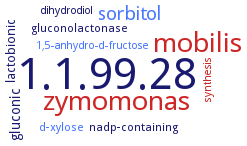1.1.99.28: glucose-fructose oxidoreductase
This is an abbreviated version!
For detailed information about glucose-fructose oxidoreductase, go to the full flat file.

Word Map on EC 1.1.99.28 
-
1.1.99.28
-
zymomonas
-
mobilis
-
sorbitol
-
gluconic
-
lactobionic
-
nadp-containing
-
gluconolactonase
-
d-xylose
-
1,5-anhydro-d-fructose
-
synthesis
-
dihydrodiol
- 1.1.99.28
- zymomonas
- mobilis
- sorbitol
-
gluconic
-
lactobionic
-
nadp-containing
- gluconolactonase
- d-xylose
- 1,5-anhydro-d-fructose
- synthesis
-
dihydrodiol
Reaction
Synonyms
EC 1.1.1.99, GFOD2, GFOR, glucose fructose oxidoreductase, glucose-fructose oxidoreductase, glucose-fructose oxidoreductase domain containing 2, Glucose-fructose transhydrogenase, NADP(H)-dependent glucose-fructose oxidoreductase, Transhydrogenase, glucose-fructose
ECTree
Advanced search results
Crystallization
Crystallization on EC 1.1.99.28 - glucose-fructose oxidoreductase
Please wait a moment until all data is loaded. This message will disappear when all data is loaded.
hanging drop method, crystal structure of oxidized preGFOR R30K/R31K, in complex with succinate (preGFOR(succ)) and with glycerol (PreGFOR(gll)), at 2.2 A and 2.05 A resolution, respectively, and of reduced preGFOR R30K/R31K, after incubation with glucose (preGFOR(Glu)) and with sorbitol (preGFOR(sorb)) at 2.5 A and 2.6 A resolution. In all four crystal structures, the signal peptide is disordered, implying a flexibility that may be important for its interaction with the translocation apparatus. The crystal structures show that the mature enzyme portion of preGFOR is identical to native GFOR, in structure and cofactor binding
-
vapour diffusion in hanging drops, crystal structure of the NAD+ complex of a truncated form of the enzyme, GFORDELTA1-22/S64D, in which the first 22 residues of the N-terminal arm of the mature protein have been deleted, structure refined at 2.7 A resolution shows that the truncated form of the enzyme forms a dimer and implies that the N-terminal arm is essential for tetramer formation by wild-type GFOR


 results (
results ( results (
results ( top
top





